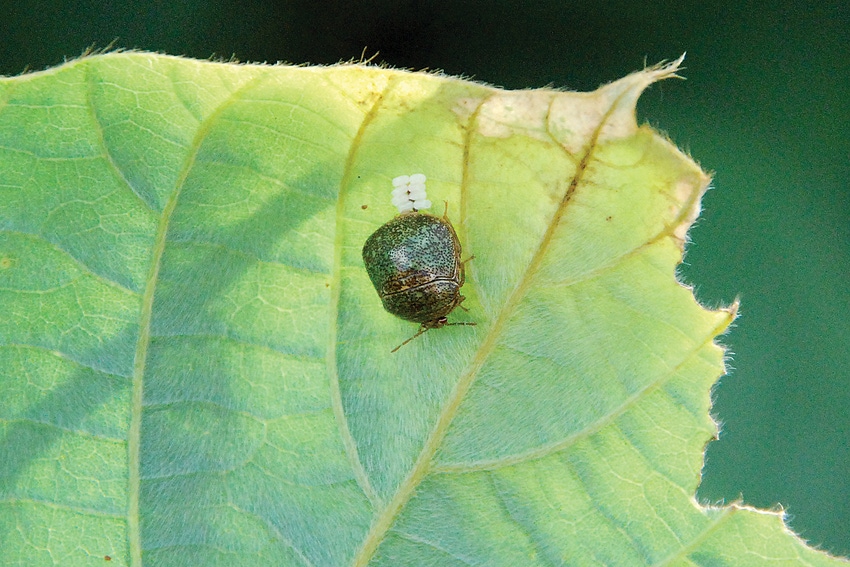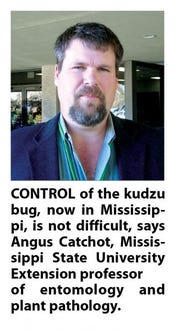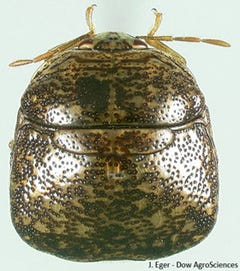
A new pest for Mississippi soybean growers and homeowners: the kudzu bug
Although the kudzu bug, a new invasive pest now confirmed in Mississippi, can cause soybean losses when populations are large, the insect can be easily controlled, says Angus Catchot, Mississippi State University Extension professor of entomology and plant pathology. "When this pest becomes established, our high management growers probably won't need to add a spray to those they're already using," he says.

Don’t panic — that’s the advice Angus Catchot offers growers about the kudzu bug, a pest of soybeans that is being found in Mississippi.
“It’s an invasive species from Asia, and you’re going to be hearing a lot about it; there will be a media blitz,” the Mississippi State University Extension professor of entomology and plant pathology told growers at a Grenada, Miss., meeting.
Entomologists and growers in the Carolinas and Georgia “already have two or three years of experience with this insect,” he says. “They know it well, and we have a lot of information about it already, so we won’t have to do a tremendous amount of research on how to deal with it.”
There are soybean losses associated with the pest when numbers get extremely high, Catchot says, “But we’ve got eyes on about every soybean acre in the state and I think our growers and consultants will be on top of it, and will manage it.
“When it gets established in soybeans — and that will happen; it may be a year, it may be two years — we can control it. Control is not difficult.
“My counterparts in states where they have the pest already tell me that our soybean producers, who are high management growers, probably won’t need to add a spray to the two or three we’re already averaging.
“If you’re a grower in the hills and don’t usually spray soybeans, but have a lot of kudzu around, you may have to add a spray for this pest. It’s possible we may have to get back to an automatic spray at R3 — we just don’t know yet.”
But, Catchot says, “I can tell you, it’s easily controlled.”
Unlike other crop pests, he notes, the kudzu bug is an urban pest and will also invade homes. “Like lady beetles, you can have hundreds of them coming inside your house — another reason the media will be all over this.”
The kudzu bug has already been identified in Alabama and Tennessee.
Catchot says the Mississippi identification was made July 11 by a former Clemson University graduate student traveling through the Vicksburg area.
“She was very familiar with the pest, and when she stopped at a Vicksburg gas station she saw six or eight of them on a vehicle. She immediately reported it to us.
“Tom Allen, Extension associate professor of plant pathology, was scouting for soybean rust a week or so later and I asked him to go by the Vicksburg area and specifically look kudzu bugs. In the first two patches of kudzu he checked, they were everywhere, both adults and nymphs.
“The area is on a major interstate highway and they likely came in on a vehicle — they’re a major hitchhiker.
“Two days ago (July 16), I was headed to Starkville, Miss., and stopped at the Pilot truck stop at Winona, located at a major intersection with a highway coming straight from Tifton Ga. I got out and walked up the hill behind the station, and the insects were everywhere in the kudzu, both adults and immatures.”
Catchot asks that growers and consultants keep a lookout for the pest and report findings to his department. “It will help us to stay on top of developments as this new insect establishes itself in the state.”
He reiterates, “I believe we can manage the kudzu bug fairly easily — but it will take some grower education over the next couple of years on what to look for and how to deal with it.”
Detailed information from Georgia
The following information on the kudzu bug is from the 2012 Georgia Soybean Production Guide.
Adult kudzu bugs are oval shaped, about ¼ inch in diameter, and greenish brown in color. Eggs are laid in double-rowed batches of 35-50 eggs and are white in color.
Nymphs are also oval-shaped and are light green to brown in color and have numerous setae/hairs. Both adults and nymphs are most commonly seen on plant stems using their sucking mouthparts to feed on plant sap.
The effects of kudzu bug feeding on soybeans are similar to drought. Excessive feeding weakens and stresses the plant, which can result in fewer pods per plant, fewer seeds per pod, and reduced seed size.
Over-wintering adults survive under pine bark and ground debris. Key reproductive hosts of kudzu bugs include kudzu, wisteria, clover and soybeans.
Adults begin laying eggs on kudzu shoots in mid-April and continue laying eggs on kudzu for several weeks.
Time required to reach the adult stage is about 6-8 weeks. These new adults then disperse to soybeans and other reproductive hosts beginning in mid-June and continuing through mid-July.
Soybeans become attractive to kudzu bug adults when plants are 8-10 inches tall. Early planted soybeans appear to be at greater risk for kudzu bug infestation compared with later planted soybeans.
Adults will begin laying eggs on the underside of soybean leaves and a generation requiring about 6 weeks will be completed on soybeans.
Initial field invasions tend to be more concentrated on field margins, but will eventually spread throughout the field. In many situations we will begin to see immature kudzu bugs in soybeans at about the R2-R3 stage.
Kudzu bugs can be scouted using a 15-inch diameter sweep net.
Kudzu bug populations can be extremely high. Georgia entomologists are suggesting a threshold of one immature kudzu bug per sweep. This suggested threshold is based on 2011 field trials where a single properly timed insecticide application preserved soybean yield.
If insecticides are applied when adults are still actively migrating from kudzu to soybeans (late June and early-mid July); additional applications may be needed.
Research is ongoing to verify and refine management and treatment thresholds for kudzu bugs in soybeans.
Multiple classes of insecticides have shown activity on kudzu bugs. Insecticide treatments containing bifenthrin, cyhalothrin, zeta-cypermethrin, carbaryl, or acephate provided greater than 80 percent control 2-5 days after treatment.
About the Author(s)
You May Also Like



